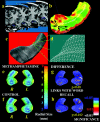Structural abnormalities in the brains of human subjects who use methamphetamine
- PMID: 15229250
- PMCID: PMC6729247
- DOI: 10.1523/JNEUROSCI.0713-04.2004
Structural abnormalities in the brains of human subjects who use methamphetamine
Abstract
We visualize, for the first time, the profile of structural deficits in the human brain associated with chronic methamphetamine (MA) abuse. Studies of human subjects who have used MA chronically have revealed deficits in dopaminergic and serotonergic systems and cerebral metabolic abnormalities. Using magnetic resonance imaging (MRI) and new computational brain-mapping techniques, we determined the pattern of structural brain alterations associated with chronic MA abuse in human subjects and related these deficits to cognitive impairment. We used high-resolution MRI and surface-based computational image analyses to map regional abnormalities in the cortex, hippocampus, white matter, and ventricles in 22 human subjects who used MA and 21 age-matched, healthy controls. Cortical maps revealed severe gray-matter deficits in the cingulate, limbic, and paralimbic cortices of MA abusers (averaging 11.3% below control; p < 0.05). On average, MA abusers had 7.8% smaller hippocampal volumes than control subjects (p < 0.01; left, p = 0.01; right, p < 0.05) and significant white-matter hypertrophy (7.0%; p < 0.01). Hippocampal deficits were mapped and correlated with memory performance on a word-recall test (p < 0.05). MRI-based maps suggest that chronic methamphetamine abuse causes a selective pattern of cerebral deterioration that contributes to impaired memory performance. MA may selectively damage the medial temporal lobe and, consistent with metabolic studies, the cingulate-limbic cortex, inducing neuroadaptation, neuropil reduction, or cell death. Prominent white-matter hypertrophy may result from altered myelination and adaptive glial changes, including gliosis secondary to neuronal damage. These brain substrates may help account for the symptoms of MA abuse, providing therapeutic targets for drug-induced brain injury.
Figures




Similar articles
-
Cerebral metabolic dysfunction and impaired vigilance in recently abstinent methamphetamine abusers.Biol Psychiatry. 2005 Nov 15;58(10):770-8. doi: 10.1016/j.biopsych.2005.04.039. Epub 2005 Aug 10. Biol Psychiatry. 2005. PMID: 16095568
-
Mood disturbances and regional cerebral metabolic abnormalities in recently abstinent methamphetamine abusers.Arch Gen Psychiatry. 2004 Jan;61(1):73-84. doi: 10.1001/archpsyc.61.1.73. Arch Gen Psychiatry. 2004. PMID: 14706946
-
Global and local morphometric differences in recently abstinent methamphetamine-dependent individuals.Neuroimage. 2010 May 1;50(4):1392-401. doi: 10.1016/j.neuroimage.2010.01.056. Epub 2010 Jan 22. Neuroimage. 2010. PMID: 20096794 Free PMC article.
-
Abuse of amphetamines and structural abnormalities in the brain.Ann N Y Acad Sci. 2008 Oct;1141:195-220. doi: 10.1196/annals.1441.031. Ann N Y Acad Sci. 2008. PMID: 18991959 Free PMC article. Review.
-
Corticolimbic dysregulation and chronic methamphetamine abuse.Addiction. 2007 Apr;102 Suppl 1:5-15. doi: 10.1111/j.1360-0443.2006.01777.x. Addiction. 2007. PMID: 17493049 Review.
Cited by
-
Predisposition to and effects of methamphetamine use on the adolescent brain.Mol Psychiatry. 2015 Dec;20(12):1516-24. doi: 10.1038/mp.2014.191. Epub 2015 Feb 10. Mol Psychiatry. 2015. PMID: 25666756 Free PMC article.
-
Morphometric abnormalities of the lateral ventricles in methamphetamine-dependent subjects.Drug Alcohol Depend. 2013 Aug 1;131(3):222-9. doi: 10.1016/j.drugalcdep.2013.05.009. Epub 2013 Jun 12. Drug Alcohol Depend. 2013. PMID: 23769159 Free PMC article.
-
Training Self-Control: A Domain-General Translational Neuroscience Approach.Child Dev Perspect. 2012 Dec;6(4):374-384. doi: 10.1111/j.1750-8606.2012.00248.x. Child Dev Perspect. 2012. PMID: 23894251 Free PMC article.
-
The Effect of Chronic Methamphetamine Exposure on the Hippocampal and Olfactory Bulb Neuroproteomes of Rats.PLoS One. 2016 Apr 15;11(4):e0151034. doi: 10.1371/journal.pone.0151034. eCollection 2016. PLoS One. 2016. PMID: 27082425 Free PMC article.
-
Effects of ecstasy/polydrug use on memory for associative information.Psychopharmacology (Berl). 2012 Aug;222(4):579-91. doi: 10.1007/s00213-012-2652-x. Psychopharmacology (Berl). 2012. PMID: 22302139
References
-
- Ashburner J, Friston KJ (2000) Voxel-based morphometry-the methods [review]. NeuroImage 11: 805-821. - PubMed
-
- Bartzokis G, Beckson M, Lu PH, Nuechterlein KH, Edwards N, Mintz J (2001) Age-related changes in frontal and temporal lobe volumes in men: a magnetic resonance imaging study. Arch Gen Psychiatry 58: 461-465. - PubMed
-
- Bartzokis G, Cummings JL, Sultzer D, Henderson VW, Nuechterlein KH, Mintz J (2003) White matter structural integrity in healthy aging adults and patients with Alzheimer disease: a magnetic resonance imaging study. Arch Neurol 60: 393-398. - PubMed
-
- Beck AT, Steer RA (1987) Manual for the Revised Beck Depression Inventory. San Antonio, TX: Psychological Corp.
Publication types
MeSH terms
Substances
Grants and funding
LinkOut - more resources
Full Text Sources
Other Literature Sources
Medical
Molecular Biology Databases
